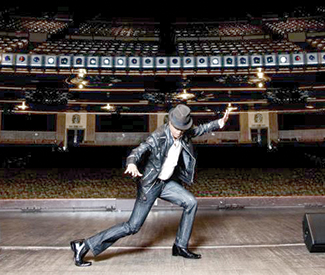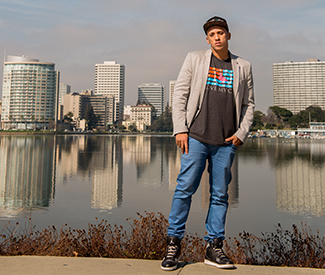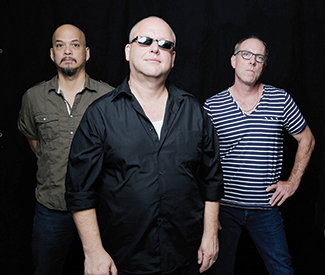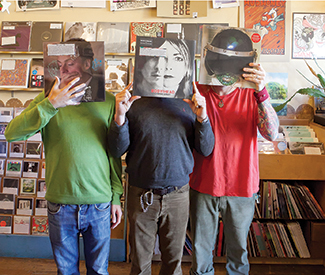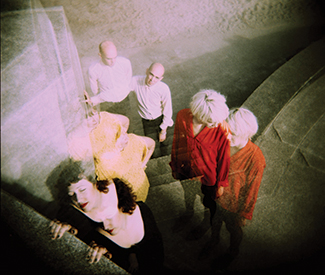esilvers@sfbg.com
LEFT OF THE DIAL Dayvid Michael, a West Oakland native and member of the CaliMade hip-hop crew, clearly has some mixed feelings about his debut record, Frienemy.
“I mean, I wrote those songs when I was 18,” says the rapper, drinking boba milk tea during an interview in downtown Oakland. “I’m still proud of them, but I’ve learned so much since then.”
That album dropped the last week of December 2012 — which means Michael’s reminiscing at the ripe old age of 21. But, to be fair, the past couple years have been big ones for someone who calls himself a “reluctant rapper” (until about age 17, he mostly wanted to sing and play guitar).
With CaliMade, a loose collective of Oakland-born guys who’ve been friends from elementary school, as well as other young DJs and producers, he performed at Hiero Day, steps away from Bay Area hip-hop legends. He’s guested on a few songs by Iamsu, a rapper whom, Michael rightly notes, you will hear if you put on 106.1 KMEL for more than 15 minutes right now; CaliMade is now working closely with the (slightly) elder rapper’s own crew, the HBK Gang. And 2014’s shaping up to be a big one: He just got done recording a new project with Azure, an Oakland rapper poised for big things in his own right as well as being Iamsu’s DJ, and Clyde Shankle, another member of CaliMade. Michael’s also working on his sophomore solo album, which will be out by the end of the year.
In other words, he’s an Oakland kid to keep your eye on — which makes him a perfect selection for Oakland Drops Beats, a new free, all-ages, quarterly music festival that features some 30-plus East Bay artists, spread out over 10 different stages and venues in downtown Oakland; the kickoff festival is April 19.
Its lineup is, in and of itself, a testament to the range of music coming out of Oakland right now: From the jazz-hip-hop blend of the Kev Choice Ensemble to the underrated indie rock of Oakland mainstays B. Hamilton to the funk-soul dance party music of Sal’s Greenhouse — not to mention a distinctly family-friendly vibe courtesy of Bay Area Girls Rock Camp and the presence of Youth Radio — the music “crawl,” as organizers are billing it, aims to serve as both a celebration of the city’s established artists and a new platform through which up-and-coming musicians can get some stage time.
Inspired by the Venice Music Crawl in LA, musician-organizer-founder Angelica Tavella first began reaching out to Oakland event producers over the summer, with the idea in mind that there are lots of community organizers and promoters “already doing cool stuff in other parts of Oakland, but really doing their own thing,” she says.
“This was, here’s a space where we could all do that together, for a couple hours, on this one day. And I really had in mind that it should be downtown Oakland — specifically not in Uptown, which already has the Art Murmur…there are a lot of great small shop owners, a lot of great energy, and cool new things going on downtown. But there aren’t a lot of venues for something like a public music performance to happen.”
Tavella was quickly overwhelmed by the level of interest and enthusiasm from business owners and event producers — especially considering that the festival is all volunteer-run for now (including pro bono performances by musicians). The goal for the next one, which will take place in the last week of July or the first week of August, is to fundraise enough to pay musicians for their performances, while keeping admission free to the public.
Eventually, Tavella hopes to have the free daytime performances segue into a nighttime music crawl that would bring business to the venues in downtown Oakland. And with more and more musicians and artists getting priced out of San Francisco and heading East, organizers shouldn’t have too hard a time finding fresh talent to fill a bill every three months.
Dayvid Michael will be performing in the afternoon with the CaliMade crew at Le Qui Vive, a gallery at 15th and Webster. He feels at home there — it’s one of the first venues where CaliMade began performing a few years ago, and he says the folks behind it are part of the community that makes him feel so lucky to be calling Oakland home.
“When people from outside the Bay Area think about the Bay Area, they think of two things — we’re hyphy, we know how to have fun; and also the diversity of the city,” says Michael, who also does graphics work for Youth Radio (he basically “hung around” until they let him). “I feel like as representatives, the HBK Gang and Cali Made can fulfill both of those perceptions. And my personal goal is to show the world that we’re more than just party music. We can do that too — but we want to offer more than that.”
“This place is so rich in culture, intelligence, legacy. I love it here,” he says, and thinks for a minute. “If Oakland had waterfalls, I would never go anywhere else.” Fair enough.
Oakland Drops Beats
Sat/19, 2pm (all day), free
10 venues between Broadway and Harrison/14th and 19th St, Oak.
www.oaklanddropsbeats.com
ONLY YOU CAN SAVE COLLEGE RADIO
Talk about “left of the dial.” If you’ve only been in the city a couple years, you might not be aware that there was a time when KUSF — that’s the student-run radio station of the University of San Francisco — wasn’t in exile. It’s been over three years since the university sold the station (which had been broadcasting since 1963 at 90.3 FM) without public input or comment, for $3.75 million, to the Classical Public Radio Network, aka CPRN, via a complex three-way deal between the University of Southern California, that station, and the corporate broadcasting giant Entercom.
Since that time, KUSF DJs and friends of the station have been operating the station online, 24 hours a day, from the Lightrail Studios, growing a registered nonprofit arm with a new name: San Francisco Community Radio. All the while, those who love the station have been embroiled in — to use the technical legal terminology — a bureaucratic shitshow, as they try to prove that the sale was illegal. They’ve had some small successes in proving certain aspects of the transaction were unlawful, and currently have an appeal before the FCC.
Then, at the end of 2013, the FCC began issuing low-power FM licenses for the first time in about a decade. KUSF-In-Exile has an application in for 102.5 — but they’re up against at least seven other groups, including, as KUSF members understand it, a mega-church. The central goal, say organizers, is simply to get back on the (non-internet based) airwaves, one way or another. But “It’s a lot of hurry up and wait,” says SFCR board member and treasurer Damin Esper of the situation. “Which, obviously, isn’t very satisfying to us or to our supporters.”
In the meantime, the station has been throwing fundraiser shows to help pay for ongoing legal fees, and the one this April 20, naturally, is the third incarnation of their annual stoner-rama affair. Oakland punks Violence Creeps, who’ll be opening for the current incarnation of Black Flag at Brick & Mortar in May, will be headlining, alongside psych-rockers Mondo Drag and plenty of other wild, weird, woolly favorites; visuals, should you happen to have ingested anything that would make you want to look at cool visuals, will be provided by veteran stock-footage auteurs Oddball Films. All of the funds raised will go to SFCR’s legal fight; there will also be members on hand to talk volunteer opportunities — college radio-loving grantwriters, are you out there?
When it comes to the original sale, Esper says, “It’s clear that laws were broken. It could be found to be illegal in court…but one of the reasons the big guys always win in situations like this is it’s hard to keep people engaged, reminded of the situation. This is bigger than just KUSF. This is happening all over the country. College radio is under attack.”
https://www.youtube.com/watch?v=a0MiS923Jfo
SFCR’s Blown-Out, Blowout Benefit III
Sun/20, 8pm, $7
Thee Parkside 1600 17th St, SF
www.theeparkside.com
Oh, one last thing: There’s also a little event called Record Store Day coming up, so get out that piggy bank — this is what people mean when they talk about having an “emergency fund,” right? Anyway: So much going on, so little space. Check the Bay Guardian’s Noise blog this week for special in-store events and one-day-only releases.







